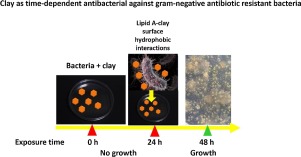当前位置:
X-MOL 学术
›
J. Hazard. Mater.
›
论文详情
Our official English website, www.x-mol.net, welcomes your feedback! (Note: you will need to create a separate account there.)
Antibacterial clay against gram-negative antibiotic resistant bacteria
Journal of Hazardous Materials ( IF 13.6 ) Pub Date : 2017-09-01 , DOI: 10.1016/j.jhazmat.2017.08.078 Luis Zarate-Reyes , Cynthia Lopez-Pacheco , Antonio Nieto-Camacho , Eduardo Palacios , Virginia Gómez-Vidales , Stephan Kaufhold , Kristian Ufer , Eduardo García Zepeda , Javiera Cervini-Silva
Journal of Hazardous Materials ( IF 13.6 ) Pub Date : 2017-09-01 , DOI: 10.1016/j.jhazmat.2017.08.078 Luis Zarate-Reyes , Cynthia Lopez-Pacheco , Antonio Nieto-Camacho , Eduardo Palacios , Virginia Gómez-Vidales , Stephan Kaufhold , Kristian Ufer , Eduardo García Zepeda , Javiera Cervini-Silva

|
Antibiotic resistant bacteria persist throughout the world because they have evolved the ability to express various defense mechanisms to cope with antibiotics and the immune system; thus, low-cost strategies for the treatment of these bacteria are needed, such as the usage of environmental minerals. This paper reports the antimicrobial properties of a clay collected from Brunnenberg, Germany, that is composed of ferroan saponite with admixtures of quartz, feldspar and calcite as well as exposed or hidden (layered at inner regions) nano Fe(0). Based on the growth curves (log phase) of six antibiotic resistant bacteria (4 gram-negative and 2 gram-positive), we concluded that the clay acted as a bacteriostat; however, the clay was only active against the gram-negative bacteria (except for resilient Klebsiella pneumonia). The bacteriostatic mode of action was evidenced by the initial lack of Colony Forming Units on agar plates with growth registered afterward, certainly after 24 h, and can be explained because interactions between membrane lipopolysaccharides and the siloxane surfaces of the clay. Labile or bioavailable Fe in the clay (extracted by EDTA or DFO-B) induced the quantitative production of HO as well as oxidative stress, which, nevertheless, did not account for by its bacteriostatic activity.
中文翻译:

革兰氏阴性抗药性细菌的抗菌黏土
抗药性细菌在全世界范围内持续存在,因为它们已经进化出表达多种防御机制以应对抗生素和免疫系统的能力。因此,需要低成本的策略来治疗这些细菌,例如使用环境矿物质。本文报道了从德国布伦嫩贝格(Brunnenberg)收集的粘土的抗菌性能,该粘土由亚铁皂石与石英,长石和方解石的混合物以及裸露或隐藏(在内部区域分层)的纳米Fe(0)组成。根据六种抗生素抗性细菌(4克阴性和2克阳性)的生长曲线(对数期),我们得出结论:粘土起到了抑菌剂的作用。但是,这种粘土只对革兰氏阴性菌有活性(除了弹性克雷伯菌肺炎)。通过在琼脂板上最初缺乏菌落形成单位来证明其抑菌作用模式,随后肯定在24小时后证明其生长,这可以解释为因为膜脂多糖与粘土的硅氧烷表面之间存在相互作用。粘土中不稳定或生物可利用的铁(通过EDTA或DFO-B提取)诱导了HO的定量生成 以及氧化应激,尽管如此,氧化应激并不能解释其抑菌活性。
更新日期:2017-09-04
中文翻译:

革兰氏阴性抗药性细菌的抗菌黏土
抗药性细菌在全世界范围内持续存在,因为它们已经进化出表达多种防御机制以应对抗生素和免疫系统的能力。因此,需要低成本的策略来治疗这些细菌,例如使用环境矿物质。本文报道了从德国布伦嫩贝格(Brunnenberg)收集的粘土的抗菌性能,该粘土由亚铁皂石与石英,长石和方解石的混合物以及裸露或隐藏(在内部区域分层)的纳米Fe(0)组成。根据六种抗生素抗性细菌(4克阴性和2克阳性)的生长曲线(对数期),我们得出结论:粘土起到了抑菌剂的作用。但是,这种粘土只对革兰氏阴性菌有活性(除了弹性克雷伯菌肺炎)。通过在琼脂板上最初缺乏菌落形成单位来证明其抑菌作用模式,随后肯定在24小时后证明其生长,这可以解释为因为膜脂多糖与粘土的硅氧烷表面之间存在相互作用。粘土中不稳定或生物可利用的铁(通过EDTA或DFO-B提取)诱导了HO的定量生成 以及氧化应激,尽管如此,氧化应激并不能解释其抑菌活性。



























 京公网安备 11010802027423号
京公网安备 11010802027423号